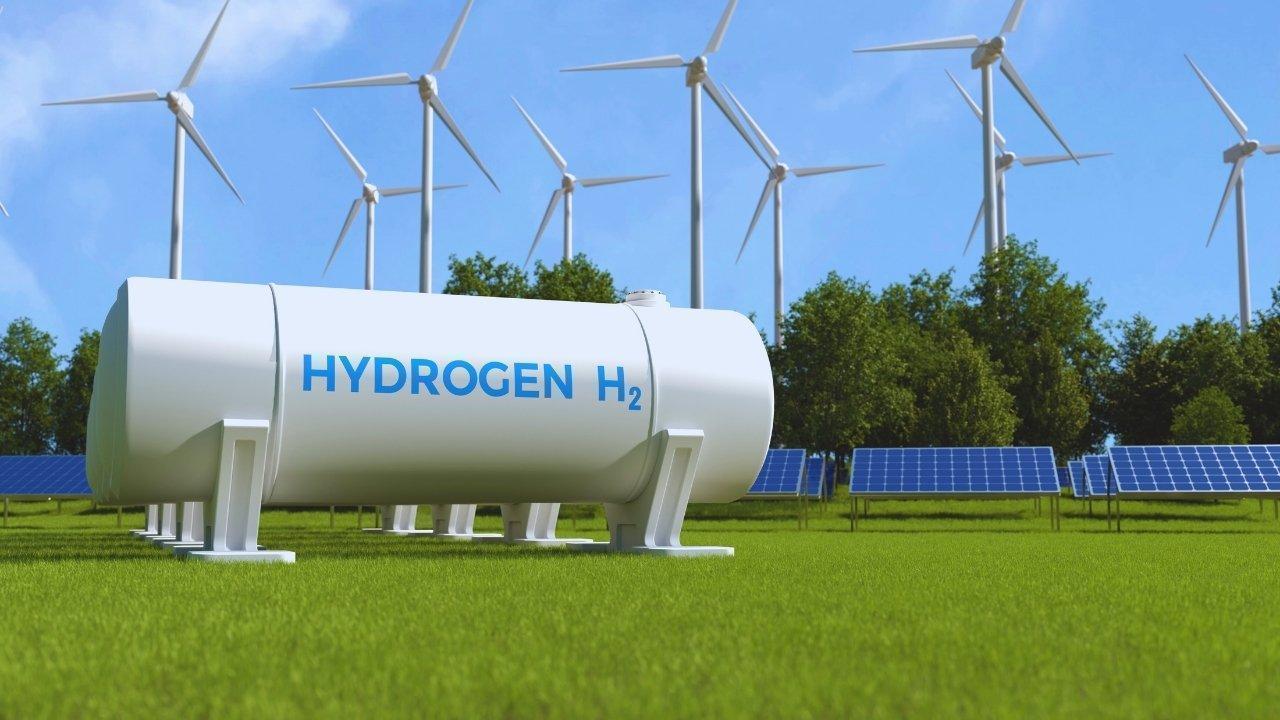
Post by : Anish
The global conversation about sustainable energy has shifted from solar and wind to something more futuristic and versatile — green hydrogen. Touted as the “fuel of the future,” green hydrogen could redefine how we produce, store, and use energy across industries. As nations race toward net-zero goals, the push to make green hydrogen scalable by 2030 is gaining momentum. Yet, the road ahead is complex, layered with challenges related to cost, infrastructure, and technological maturity.
Hydrogen itself isn’t new. It has powered rockets, fueled industries, and been used for decades in chemical production. What’s new is how it’s made. Traditional hydrogen production often relies on natural gas, which emits large amounts of carbon dioxide — known as “grey hydrogen.”
Green hydrogen, however, is produced using renewable electricity (from solar, wind, or hydro) to split water into hydrogen and oxygen via electrolysis. The process emits no greenhouse gases, making it a truly clean fuel.
This shift could reshape energy-intensive sectors such as transport, steel, and fertilizers — industries where electrification alone isn’t enough. The key lies in scaling the production economically and ensuring the infrastructure can support widespread adoption.
The urgency of transitioning to green hydrogen stems from the limitations of current renewable technologies. Solar and wind, while powerful, are intermittent. Batteries can store some energy, but not at the industrial scale required to power global economies continuously.
Hydrogen, however, can be stored long-term and transported across borders. It can also be converted back into electricity or used as a feedstock for industrial processes.
For nations like Japan, Germany, and India, hydrogen is more than just a clean fuel — it’s a pathway to energy independence. As geopolitical tensions disrupt traditional oil and gas supply chains, hydrogen offers a chance to decentralize energy production and create domestic resilience.
The 2030 timeline sounds ambitious, but governments and corporations are pushing hard. The European Union’s Green Deal, the U.S. Inflation Reduction Act, and India’s National Hydrogen Mission all set aggressive targets for hydrogen production and use within this decade.
However, experts argue that scalability depends on three primary factors: cost, efficiency, and infrastructure. Currently, green hydrogen costs around $4–6 per kilogram, compared to $1–2 for grey hydrogen. Bringing this cost down requires cheaper renewable energy, improved electrolyzers, and economies of scale.
According to projections, with technological innovation and mass adoption, green hydrogen could reach parity with fossil-fuel-based hydrogen by 2030. But it will demand global collaboration, massive investment, and policy consistency.
Innovation is rapidly improving hydrogen economics. Next-generation electrolyzers are becoming more efficient, capable of converting a higher percentage of electricity into hydrogen. Additionally, advancements in materials science are reducing equipment costs and extending the lifespan of hydrogen systems.
Countries like Australia and Saudi Arabia are investing heavily in large-scale hydrogen plants powered entirely by renewables. In Europe, pilot projects are integrating hydrogen into existing gas pipelines, while Japan is experimenting with hydrogen-powered ships and trains.
The most promising development, however, lies in hybrid systems — combining renewable energy production directly with hydrogen generation, minimizing energy loss. This could drastically improve cost-efficiency and make continuous production possible, even in variable weather conditions.
While technology is catching up, the economic and policy landscapes remain uneven. Many nations still lack standardized regulations for hydrogen transport, storage, and safety. Without coherent policies, private investment remains cautious.
Furthermore, the high initial cost of setting up electrolyzers and renewable infrastructure is a major barrier for developing countries. The financial burden of transitioning from fossil fuels to hydrogen-based systems could exacerbate global inequality unless supported by international financing mechanisms.
Policy frameworks like carbon pricing, tax incentives, and public–private partnerships will be key to overcoming these challenges. Global coordination — similar to what was achieved with the Paris Agreement — is essential for aligning hydrogen strategies and ensuring fair participation across regions.
Producing green hydrogen is only half the challenge — transporting and storing it is equally demanding. Hydrogen’s low density means it must be compressed or liquefied for storage, requiring significant energy input. Current pipelines are not always suitable for hydrogen, and new infrastructure would cost billions to develop.
However, new technologies are emerging. Ammonia-based transport, for example, allows hydrogen to be moved safely and efficiently before being converted back to pure hydrogen at the destination. Similarly, blending hydrogen with natural gas in existing pipelines offers a transitional solution while new infrastructure develops.
Nations leading in this domain, such as Japan, Germany, and the UAE, are already building dedicated hydrogen ports and transport networks — signaling a global race to dominate the hydrogen supply chain.
Major industries are beginning to see hydrogen not just as a clean alternative but as a long-term investment. Steelmakers like ArcelorMittal, automobile giants like Toyota and Hyundai, and aviation companies are experimenting with hydrogen-based fuels.
In transportation, hydrogen fuel cells are emerging as a viable option for long-haul trucks and ships — sectors where batteries fall short due to weight and charging limitations. The International Energy Agency (IEA) estimates that global hydrogen demand could triple by 2030, primarily driven by industrial and mobility applications.
The question remains whether production can keep pace. Without matching supply, prices will remain high, limiting its competitiveness against fossil fuels.
While green hydrogen promises cleaner energy, its production still demands vast amounts of water and electricity. In regions facing water scarcity, this could lead to environmental stress. Responsible production practices and the use of seawater desalination or wastewater recycling could help mitigate these concerns.
Moreover, hydrogen infrastructure projects must also consider local communities, ensuring job creation and equitable benefits. Transitioning to a hydrogen economy shouldn’t merely serve industrial interests but also empower workers transitioning from traditional energy sectors.
For green hydrogen to become a global energy pillar, collaboration is essential. Developed nations must support technology transfer and funding for emerging economies. The focus must be on creating a balanced ecosystem where hydrogen is accessible, affordable, and sustainable.
The International Renewable Energy Agency (IRENA) predicts that hydrogen could account for 12% of global energy demand by 2050 if current momentum continues. Reaching that goal begins with hitting the 2030 scalability milestone.
Achieving this will require synchronized global effort — governments providing clear policies, industries investing in innovation, and the public embracing hydrogen as a viable alternative. The world is closer than ever, but the clock is ticking.
The next five years will determine whether hydrogen becomes the cornerstone of the green transition or another overhyped idea lost to economic reality. As nations race to deploy clean technologies, hydrogen stands out as both an opportunity and a challenge — one that could redefine the entire energy system if managed wisely.
If green hydrogen scales successfully by 2030, it could revolutionize how we think about fuel, emissions, and sustainability — not just for industries but for the planet’s future.
This article is intended for informational purposes only. It provides a general overview of current trends and projections regarding green hydrogen and the global energy transition. Readers should verify facts through official energy and environmental sources before drawing conclusions.










Google to Invest $15 Billion in India’s AI Data Hub
Google will invest $15 billion to build a massive AI data hub in southern India, marking its largest

Gautam Gambhir Praises Shubman Gill’s Leadership Success
India’s head coach Gautam Gambhir praised Shubman Gill’s leadership after the 2-0 Test series win ov

KL Rahul Guides India to Series Win Over West Indies 2-0
India defeated West Indies by seven wickets in the second Test, sweeping the series 2-0 with KL Rahu

China Launches Shiyan-31 Test Satellite Successfully
China successfully launches Shiyan-31 satellite to test optical imaging technology, marking the 599t

Coach to Decide if Messi Plays Against Puerto Rico
Argentina coach Lionel Scaloni will decide Lionel Messi’s participation against Puerto Rico after fi

Pedri Credits Ferran Torres For Support And Guidance
Pedri highlights Ferran Torres’ support and guidance, saying strict advice and teamwork keep him mot